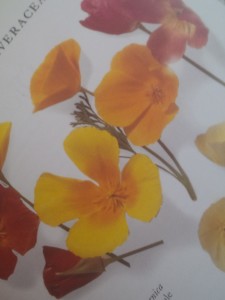
Every day in New York and Los Angeles, any number of aspiring actors toil in obscurity, awaiting the moment when they will be “discovered” by someone who can launch their stage and screen careers. Once upon a time, a flashy horticultural performer with the ungainly name of Eschscholzia californica, had a story much like that.
Back in 1825, a short-lived, but extremely well traveled Scottish plant hunter, David Douglas, was on an expedition through the northwestern United States. He collected seeds of many large conifers, including the beautiful Douglas fir, whose common name pays tribute to its discoverer. Fortunately for gardeners everywhere, Douglas did not neglect smaller specimens and collected seeds from a little plant with feathery, gray-green leaves and bright orange flowers.
That native plant was described by Douglas’ contemporary, botanist Adelbert von Chamisso and named after Chamisso’s friend, an entomologist by the name of Eschscholz.
Any starlet with a moniker like “Eschscholzia” obviously needs a more manageable stage name, and in this case, “California poppy” was it. Douglas sent the seeds back to England, where the beauty of the four-petaled flowers and ease of culture brought them popularity. Though horticultural fashions ebb and flow, California poppy has been a long running hit in its home country and across the oceans. Californians also had the good sense to proclaim the scrappy poppy their state flower.
It is easy to see why. Usually grown from tiny seeds, the plants are annuals in cold winter climates and short-lived perennials where winters are warm. Individual plants grow eight to twelve inches tall, making them perfect for border and bed fronts, not to mention containers and window boxes. The leaves are delicate and somewhat reminiscent of artemisia, rendering the poppies attractive even when not in bloom. Self-seeding, the salvation of cottage gardeners everywhere, is almost a given with California poppy, but the species never crosses the line into invasiveness. Any unwanted eschscholzias are easy to grub out and a single seed packet is likely to provide you with years of blooms.
Though small in stature, California poppies are true members of the Papaveraceae family and kin to the showy oriental poppies, the winsome Shirley poppies and the intoxicating annual bread poppies or Papaver somniferum. All feature crepe paper-like petals and a delicate appearance that belies a tough constitution.
Like the aspiring starlet it once was, the California poppy likes a warm place in the sun. If you are interested in attracting pollinators to your plantings, they are a garden “must”. Summer is high poppy season and once established in well-drained soil, the plants tolerate drought well. Like all annuals, California poppies appreciate deadheading, which stimulates more bloom. At the end of the season, leave some seedheads on the plants for self-seeding.
Plant breeders have warmed to California poppy over the years and expanded its form to encompass semi-double and double-petaled varieties. The original color range of red or red-orange has also expanded to include everything from cream to shades of pink, rose and near-purple. Bi-colors are also widely available. A popular seed mix, ‘Jellybean’ includes double-flowered poppies with petals decked out in all the above colors in varying arrays of stripes, splashes and ombre-type shadings. I especially love ‘Peach Sorbet’—which sounds delicious—and produces subtly shaded golden-peach colored flowers. For a more tranquil look, try ‘White Linen’. It is more ecru than white, but offers gorgeous single blooms with ruffled petal edges.
The only downside of California poppies is that they do not make particularly good cut flowers. For a one-day stand in a vase, they will do fine, but their petals will close shortly thereafter. My advice would be to leave them to shine in the garden and choose other blooms for indoor arrangements.
Almost every retail seed vendor carries at least one or two varieties of California poppy and you can start looking for them online, or at nurseries and garden centers this month. The easiest way to start them is by direct seeding in the garden or in containers after all danger of frost has passed. Follow the package directions; add a little water and a modicum of patience, and next summer you will be able to applaud while bonfire California celebrities perform regular star turns in your garden.
